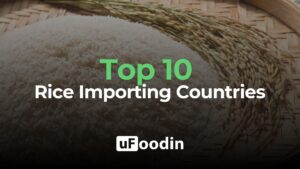
Top 10 Rice Importing Countries
Rice, a staple food for more than half of the global population, is a critical component of international trade. In 2023, the global rice import market was valued at over $30 billion, with the Top 10 Rice Importing Countries accounting for more than 70% of global imports. This trade is fueled by growing populations, urbanization, and changing dietary habits.
While traditional markets like China and the Philippines dominate imports by volume, emerging economies in the Middle East and Africa are driving growth due to increasing demand for premium and specialty rice varieties. This article highlights the Top 10 Rice Importing Countries, examines key trends, and discusses challenges facing the rice trade.

1. China
- Import Value: Over $5.8 billion (2023)
- Why It Stands Out: China is the largest rice importer globally, driven by demand for high-quality and specialty rice to supplement domestic production.
- Key Insights: Major suppliers include Vietnam, Thailand, and Pakistan, focusing on jasmine and fragrant rice varieties.
2. Philippines
- Import Value: Approximately $2.5 billion (2023)
- Why It Stands Out: The Philippines relies heavily on rice imports to meet domestic consumption needs due to production shortfalls.
- Key Insights: Vietnam and Thailand are the primary suppliers, with rising demand for affordable white rice.
3. Saudi Arabia
- Import Value: Around $1.8 billion (2023)
- Why It Stands Out: Saudi Arabia’s reliance on imported rice stems from its arid climate and growing demand for premium basmati and jasmine rice.
- Key Insights: India and Pakistan dominate the supply chain, catering to local preferences for high-quality grains.
4. Iran
- Import Value: Over $1.5 billion (2023)
- Why It Stands Out: Iran’s demand for premium basmati rice drives its imports, particularly for cultural and traditional dishes.
- Key Insights: India is the leading supplier, followed by Pakistan, meeting the demand for fragrant and long-grain varieties.
5. Indonesia
- Import Value: Approximately $1.4 billion (2023)
- Why It Stands Out: Indonesia imports rice to stabilize domestic prices and address production shortfalls during seasonal gaps.
- Key Insights: Vietnam and Thailand are key suppliers, providing affordable white rice.
6. Nigeria
- Import Value: Around $1.3 billion (2023)
- Why It Stands Out: Nigeria’s large population and growing urban centers drive demand for imported rice, despite government efforts to boost local production.
- Key Insights: India and Thailand dominate imports, focusing on parboiled and white rice.
7. United States
- Import Value: Over $1.1 billion (2023)
- Why It Stands Out: The U.S. imports specialty and fragrant rice varieties to cater to its diverse population and ethnic cuisines.
- Key Insights: Thailand, India, and Vietnam are leading suppliers, with jasmine and basmati rice in high demand.
8. Malaysia
- Import Value: Approximately $1 billion (2023)
- Why It Stands Out: Malaysia’s heavy reliance on imported rice ensures a stable supply for its population.
- Key Insights: Thailand and Vietnam are the main suppliers, focusing on affordable and fragrant varieties.
9. Iraq
- Import Value: Around $950 million (2023)
- Why It Stands Out: Iraq’s imports support its growing population and reliance on rice for staple dishes.
- Key Insights: India and the U.S. dominate the supply chain, catering to demand for basmati and long-grain rice.
10. South Africa
- Import Value: Over $850 million (2023)
- Why It Stands Out: South Africa imports rice to supplement local production, focusing on affordable and parboiled varieties.
- Key Insights: Thailand and India are key suppliers, meeting demand from both households and the foodservice sector.
Key Trends in Rice Imports
Rising Demand for Specialty Rice:
Jasmine, basmati, and organic rice varieties are gaining popularity in premium markets.Urbanization Driving Convenience:
Urban populations prefer parboiled and quick-cook rice for convenience.E-Commerce Platforms Boosting Sales:
Online platforms are facilitating the trade of niche rice varieties directly to consumers.Shift Toward Healthier Options:
Organic and low-glycemic index rice varieties are seeing increased demand.Diversification of Suppliers:
Importers are expanding their sourcing networks to mitigate risks and ensure supply stability.Increased Focus on Sustainability:
Eco-friendly packaging and sustainable farming practices are becoming priorities for exporters and importers alike.

Major Challenges in Rice Imports
Climate Change Impacts:
Erratic weather patterns and droughts are reducing yields in key producing regions.Geopolitical Tensions:
Trade restrictions and export bans in producing countries disrupt global supply chains.Logistical Issues:
Rising freight costs and port congestions create challenges for timely delivery.Price Volatility:
Fluctuations in global rice prices due to production changes and demand spikes create uncertainty for importers.Food Security Concerns:
Import-dependent nations face challenges in maintaining consistent supplies during global crises.Sustainability Pressures:
Consumers and governments are demanding transparency in farming practices and carbon footprints.
The Top 10 Rice Importing Countries highlight the global reliance on rice as a staple food and the opportunities it presents for exporters. From China’s demand for specialty varieties to Nigeria’s need for affordable options, each market offers unique growth potential.
Platforms like uFoodin facilitate seamless connections between producers and importers, providing tools to track market trends, manage logistics, and ensure compliance with sustainability standards. With access to over 210 countries, uFoodin empowers stakeholders to navigate challenges and capitalize on the growing rice trade.
By leveraging uFoodin, exporters can build long-term partnerships, enhance transparency, and expand their reach in an evolving global marketplace.
uFoodin Editorial Team
Bibliography
- FAO: Rice Trade and Production Statistics
- Statista: Global Rice Import Market Trends
- MarketWatch: Challenges in Rice Supply Chains
- Reuters: Rice Import Insights and Market Dynamics
- Grand View Research: Rice Trade Analysis
- Mordor Intelligence: Rice Import Forecasts
























